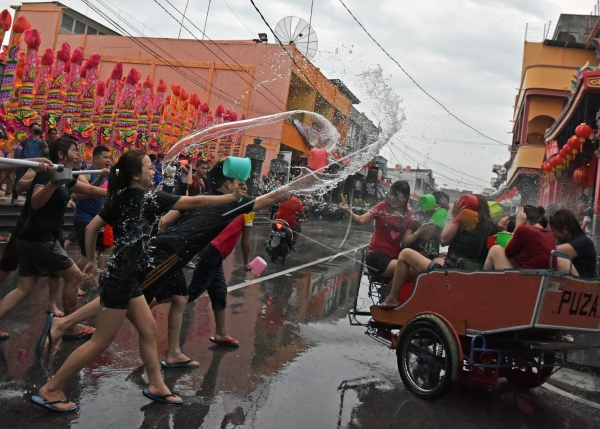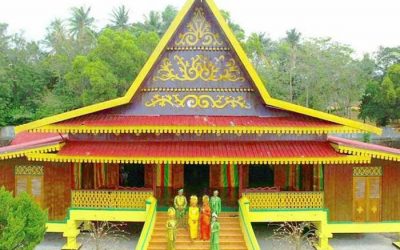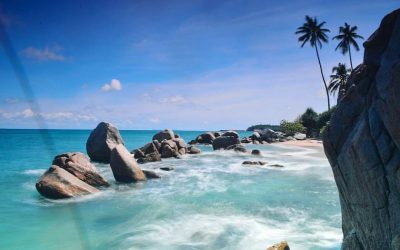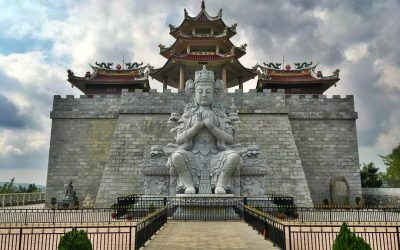Home / Batik Regions – Western Indonesia – Northern Sumatra – Riau Islands / Cian Cui Festival in Selat Panjang
Cultural Destination
Cian Cui Festival in Selat Panjang

The splashing war in Cian Cui Festival (photo: wprihandina)
Cian Cui Festival
Cian Cui Festival is originally an annual tradition of the Chinese descendants in Selat Panjang (Panjang Strait) to celebrate Chinese New Year. Today the tradition becomes the intercultural festivity celebrated by other ethnics such as Java, Minang, and Malay communities, as well as attracts international tourists from neighboring countries. All domestic and international tourists participants were joining the water splash war using water guns, buckets, and scoops, sometimes even using a water compressor machine to splash each other along the 4 kilometers route from Kartini street, to Imam Bonjol, Ahmad Yani and Diponegoro streets. The festival also includes some religious practices such as night prayer in the Buddhist shrines, jazz festival, lantern festival and then followed by firecrackers and fireworks. Do you want something special for your next vacation? Immerse in the atmosphere and be prepared to get soaking wet in the area of the Cian Cui!
Tourist Attractions in Riau Islands
Daik Lingga Royal Palace
The wonder of the Riau – Lingga royal palace complex consists of
Bintan Trikora Beach
If you want to see a stunning view of granite beach, this place offers a great
Ksitigarbha Buddhist Temple
The Bodhisattva Ksitigarbha is known as the Buddhist temple with a thousand faces
Riau Islands
Batik Motifs
Ikan tambal
The word “Ikan” refers to fish. The philosophical meaning of Ikan Tambal means is
Tikar Natuna
The Tikar Natuna motif is adapted from the traditional making of pandanus mats in
Gonggong Beruntun
This motif illustrates that a person should maintain a positive attitude and
Gonggong Siput
Gonggong (Strombus Turturella) is one type of sea snail found around
Discover
Indonesian
Batik
Motifs
Salakanagara
Salakanagara batik motif illustrates the first kingdom in the Betawi land
Parang Seling
Parang Seling or “alternating daggers” is a royal batik motif. It is a feminine variant of
Manguni Minahasa
Manguni is identified as the symbol of the Minahasa people. Manguni is known as a
Bintik Tujuh
The Bintik Tujuh (Seven Dots) motif has 7 white spots and green color gradation as
Keluak Daun Pakis
The word “Keluak” is a Minang language which means twisted or tangled. The Motif of
Gonggong Siput
Gonggong (Strombus Turturella) is one type of sea snail found around
Bultiya
The word ‘Bultiya’ is an acronym of the three major tribes in North Kalimantan, namely
Tenun Bima
The motifs are adopted from Bima woven textile. This pattern has received a great
Burung Bidadari
Bidadari birds are endemic birds in Halmahera. This motif represents an
Hiu Taliyasan
Indonesia is also home to the world’s largest fish, the whale shark (Rhincodon typus). Hiu Taliyasan refers to
Srimanganti
The name of the Srimanganti motif is derived from Palace’s hallway that connects to
Jumputan Bintang
The word Jumputan means the tie-dye technique, while the word “Bintang” refers to
Sekomandi
Its philosophical meaning is the eternal union which refers to a saying “until death do us part”
Merak Ngeram
The hatching peacock motif has a very deep meaning which refers to the sacrifice and
Kain Cual
Cual textile tradition has existed since the 17th century. The word “Cual” refers to
Pohon Hayat (Tree of Life)
The Batik motifs in Lampung are dominated by the acculturation of Buddhist and
Awan Berarak
Awan Berarak is a combination of Dayak motifs and Malay patterns. The word ‘Awan Berarak’ means the
Honai
The Honai is inspired by the traditional house of the Papuan community living in
Bekantan Pakis
This motif represents Pakis Haji (Polystichum setiferum), an endemic plant in
Tanah Liek
The word “Tanah Liek” refers to clay in Minang language. It is also known as
Tubo Kelapa
Coconut tree is a symbol of a good character and strong mentality. It illustrates the more success a person, the more
Cengkeh
The clove flower motif is the main commodity of the Tolitoli Regency. This motif represents
Teguh Bersatu
This batik motif shows the strength of the people of Kupang. It also represents a sense of
Lontara
The Lontara script itself is a typical ancient script of Bugis and Makassar communities. History records that
Bomba Mawar
This motif means sacred love for family, kingdom, and God; It also illustrates
Enggang Dayak
Local people beliefs that hornbills are an incarnation of the Commander of the Birds. It has supernatural
Mahkota Siger
Siger is the crown of a noblewoman in ancient time. It is a symbol of femininity, strength, and
Dayak Kamang
Kamang motif is generally found in the Dayak tribe shield because it is believed to
Rumah Mamuju
the Batik motif illustrates the house of Mamuju King with the stairs, located on the left of the wooden stage house
Sekar Jati
Sekar means flower and Jati refers to teak trees that symbolizes a strong mental character that
Kaharingan
The Kaharingan or ‘tree of life’ based on the Dayak tribes’ belief system. This tree symbolizes
Kawung
The Kawung motif was created by Sultan Agung Hanyokrokusumo (1593 – 1645) as a symbolic gift for
La Galigo
La Galigo is a literary work of the Buginese Epic that has 300 thousand epic lines. It is considered even
Besurek Rafflesia
The term “Basurek” refers to a textile that contains letters or inscriptions
Kaganga Tanah Rejang
If Batik Besurek combines Arabic calligraphy motifs, then the Kaganga batik takes
Desa Na Tolu
The Desa Na Tolu characteristic pattern symbolizes the Batak philosophy of existence and
Sero Tangga
The Sero Tangga illustrates an endearing feeling and sacrifices of a person to fulfil
Tikar Natuna
The Tikar Natuna motif is adapted from the traditional making of pandanus mats in
Karawo Mahkuta
Mahkuta refers to Gorontalo’s traditional crown. It represents noble characters of
Insang Ikan
Insang refers to the gills of the fish. This is a typical pattern of Malay ethnic who inhabits
Pucuk Rebung Riau
Pucuk Rebung symbolizes heart determination in achieving goals, good luck, and
Wirasat
Wirasat or divine inspiration is a gift from God. This inspiration is symbolized by
Ake Patra
Ake is related to the divinity and the composition of the universe. It is a symbol of
Karawo Pinang
Pinang refers to the Palm areca tree. This motif is considered as the original
Pati-Pati Pinehiku
It symbolizes the hierarchy in society and the social status of the Mekongga
Kerawang Tegak Aceh
The Vertical Upright (Kerawang Tegak) Motif symbolizes a person who has a strong
Buketan Bali
The Balinese bouquet (Buketan Bali) is a floral arrangement and the name is
Malinau Cultural Festival
You will witness a unique competition that might not be found other than in
Kasih Tak Sampai
‘Kasih Tak Sampai’ is an idiom in the Indonesian language which refers to
Pala Salawaku
This motif illustrates the unique weapons of the Maluku region, namely
Gedhog Kembang Waluh
a combination of Javanese cultural motif of the Majapahit kingdom (XII-XIV century) with
Leuit Sijimat
This motif reflects the daily activities of the Baduy tribe in Banten. The main ornaments of batik motif consist of:
Gonggong Beruntun
This motif illustrates that a person should maintain a positive attitude and
Parang Rusak
Another meaning behind this motif is an unconquerable spirit, symbolized by
Taiganja
Taiganja is a precious gold pendant that shows the social status of the Kaili family. It is
Gamolan
This motif illustrates Gamolan, a bamboo musical instrument of Lampung that is
Gentala Arasy
Built as high as 80 meters, the tower also highlights the historical side of
Tabir Tanjung
Tanjung flower is a type of Cherry tree flower, which is commonly found in
Jupri Kembang Teh
Kembang Teh illustrates the tendrils of tea plants that grow in the highlands of
Rangkiang
The word “Rangkiang” refers to the rice granary in the Minangkabau language. It symbolizes
Biji Kopi
The coffee seeds motif illustrates the pride of local coffee specialities in
Prada Papua
The word “Prada” in the Javanese-Indonesian dialect means a batik textile that
Wakatobi
It symbolizes the coastal beauty of the Wakatobi island and the symbol of Patra symbolizes
Tongkonan
Toraja’s traditional house is called Tongkonan. Tongkonan is a place for
Tengkawang Ampiek
With its many advantages, the Dayaks use this leaf in ritual ceremonies. This plant is a symbol of
Kuda Kupang
Horses symbolize wealth. It contains noble values of virtuous characters that bring
Angsa Duo
According to legend, the Angso duo batik motif is a pair of swans that are believed to have led Princess
Paqbarre Allo
The word “Barre” means round and “Allo” means the sunlight. This motif is interpreted as
Gorga Simeol-Meol
The Gorga Simeol-meol is a pattern of plant tendrils. it is regarded as a symbol of longevity and
Daun Lada Hitam
The black pepper motif represents the main commodity of Bangka Belitung
Daun Sirih
This motif illustrates betel leaves that are used by Lombok communities as traditional
Tifa Totobuang
The batik motifs illustrate Maluku’s traditional music instrument called
Gajah Way Kambas
The motif illustrates the Lampung’s natural reserve, the Way Kambas. it also symbolizes



